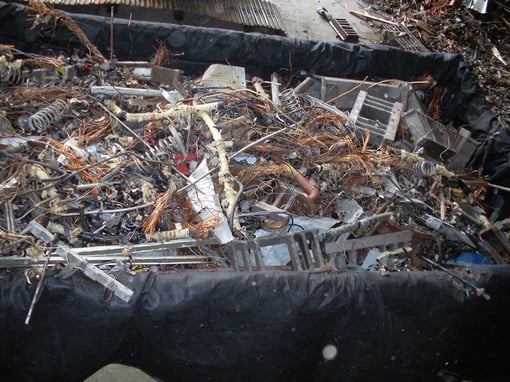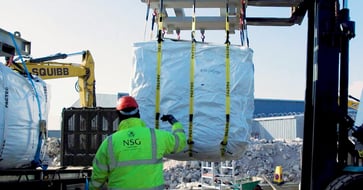We’ve seen some amazing advancements in flexible waste packaging and innovative ways to use them in our 32 years in the waste industry. However, we have also seen some cringeworthy mistakes that are often real head-scratchers. Typically, when customers are looking to make the switch from rigid containers to flexible packaging, they ask us many questions about their safe usage, best practices, and operational instructions. We can all agree this is the smart way to go about keeping your employees and worksite safe, but things often go terribly wrong for those trying to rush work or cut corners to meet deadlines.
In this PacTec insider exclusive, we will look at 7 of the most cringeworthy flexible waste packaging mistakes that should (and can easily) be avoided to maintain safe working conditions at your worksite.
1. Not getting lined bags
PacTec’s flexible waste packaging comes in many styles with various layering options. One of the most epic fails we have seen is when customers try to load waste with a high moisture content into bags not rated for wet waste. This quickly leads to packaging leaking into your truck or flatbed, and eventually onto roadways while in transit.
This type of oversight can have disastrous consequences for the environment and lead to EPA fines for the waste hauler. By properly communicating the details and composition of your waste stream to our waste packaging professionals in advance, we can help you determine if the addition of a polyethylene liner is appropriate for you.
2. Disregarding posted SWL
All waste packaging, rigid and flexible, are tested to meet regulations for Safe Working Load. Too often, we see users fill LiftPacs® or TransPacs® to their physical capacity instead of to their safe weight capacity. While this may be acceptable for certain waste types, especially heavy or dense waste streams will not always fill the physical dimensions of the packaging. For example, PacTec’s IP-1 and IP-2 packages are tested and certified to different standards with differing SWL, dimensions and break points.
Overfilling bags is one of the major causes of industrial accidents. To avoid this, make sure you do not exceed the safe working load capacity while loading. All PacTec’s packages either have the SWL printed on the packaging itself or is listed on the tag. If you do not know the SWL of your bag, you can reach out to our team at any time for clarification.
3. Assuming all packaging is created equal
Since the proliferation of flexible industrial and nuclear waste packaging, many manufacturers have begun to fabricate bags for customer use. However, customers tell us that not all packaging is created equal, and they’ve fallen victim to opting for “cheaper” options to meet their budget, only to need PacTec packaging to clean up after other bags fail them in the field.
It is important to properly vet your manufacturing partners, looking for certifications, documented quality procedures and the like. At PacTec, quality is one of the bedrocks of our existence, and we are very proud of our ISO 9001:2015 certification, our ongoing quality programs, and the thorough product testing and certification programs implemented to deliver you the best solutions possible.
4. Not obeying safe practices
All companies and jobsites have their own set of safe working practices. Similarly, waste packaging has safe handling guidelines to ensure no one is injured and waste is properly contained. For flexible waste packaging, these steps are straightforward. Inspection of the product before use, safe practices for loading, lifting, and storing, plus other considerations for roadworthiness or long-term storage.
We’ve prepared a general Safety Handling Guide for bulk bags and other FIBCs which can be found here. We also recommend you obtain any product-specific safe handling instructions upon purchase. Plus, our Low Level Waste (LLW) nuclear-specific IP-1 and IP-2 packages come with individualized operating instructions.
5. Loading incorrect waste types
In addition to the high moisture content waste discussed above, there are many other considerations when choosing which flexible waste packaging is best suited for your waste stream. For example, high temperature residuals will need a specially designed package to handle such temperatures without degrading, while sharp objects including construction debris will benefit from the addition of a nonwoven fabric layer to prevent punctures.
Not many off-the-shelf flexible packages will have these features, especially where FIBCs and bulk bags are concerned. Loading sharp objects or high heat wastes into bulk bags will lead to product failure and dangerous conditions. Avoid these by properly evaluating and selecting a suitable package for your needs.

6. Not using all lifting loops
As a rule of thumb, most PacTec flexible packages should be lifted with all their loops. Loop lifting creates the right balance, which prevents tears, uneven loads, and dislodgements – which can lead to dangerous working conditions.
Some flexible waste packages are designed as a single-pick system, but not all – best to check the installation/usage instruction or with your PacTec representative. Lifting by too few loops, or just a single loop will cause the load to shift, put undue strain on the bag and cause failure, leading to an accident or other loss in your facility.

7. Improperly storing
Not all loaded waste packages are destined for immediate transport to a disposal facility, so proper storage methods must be used. These include safe, stable stacking configurations and ensuring packages do not protrude from their pallet/platform. Indoor, climate-controlled storage is ideal, but if you must store outdoors, care should be taken to prevent exposure to extreme elements like direct sunlight and harsh wind or rain conditions.
PacTec has prepared some best practices for the safe handling and storage of your containers and can be found in our Resource Center.
In Conclusion
One wrong waste handling move could mean far-reaching cringeworthy consequences for everyone in your facility, and even innocent passersby. To keep everyone safe, make sure you adhere to industry standard safe handling practices. If you need other professional advice, speak with a PacTec representative – they'll be happy to help.




